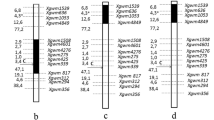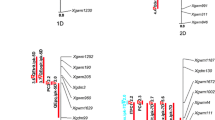Summary
A durum wheat cultivar Langdon (LDN) and fourteen disomic D genome chromosome substitution lines of Langdon, where A or B genome chromosomes were replaced with homoeologous D genome chromosomes of Chinese Spring (CS), were used to assess the compensatory effect of the D genome chromosomes on photosynthetic rates at tetraploid level. The LDN 1D(1B) and LDN 3D(3B) lines showed significantly higher photosynthetic rates than ‘Langdon’, whereas LDN 1D(1A) and LDN 3D(3A) lines were not greatly different from ‘Langdon’. It appears that chromosomes 1B and 3B decrease photosynthesis. This suggests the differentiation of the effects on the photosynthesis within the first and third homoeologous groups. Substitution with the 2D chromosomes did not compensate the effects of either 2A or 2B chromosomes as it reduced photosynthetic rate compared to plant with either chromosomes 2A or 2B. Tetra CS had a higher photosynthetic rate than CS and Penta CS. The photosynthetic rate of CS was similar to that of Penta CS, which lacked one set of D genome. The results suggest that it may be possible to increase photosynthesis, if both sets of the D genome were entirely removed from hexaploid wheat. However, it is difficult to conclude that the lower rate of photosynthesis of the hexaploids was mainly attributable to D genome chromosome effects, because we did not find a dose dependent effect of D genome. Homoeologous differentiation of chromosomes may be involved in photosynthesis.
Similar content being viewed by others
References
Arnon D.I., 1949. Copper enzymes in isolated chloroplasts. Polyphenoloxidase in Beta vulgaris. Plant Physiol. 24: 1–5.
Austin R.B., C.L. Morgan, M.A. Ford & S.G. Bhaghat, 1982. Flag leaf photosynthesis of Triticum aestivum and related diploid and tetraploid species. Ann. Bot. 49: 177–189.
Austin R.B., C.L. Morgan, M.A. Ford, T.J. Roscoe & T.E. Miller, 1988. Increasing the photosynthetic capacity of wheat by incorporating genes from A genome diploid species. In: T.E. Miller & R.M.D. Koebner (Eds). Proc 7th international wheat genetics symposium, pp. 203–208. IPSR Cambridge Lab., Cambridge, UK.
Austin R.B., M.A. Ford, C.L. Morgan & T.E. Miller, 1984. Genetic constraint on photosynthesis and yield in wheat. In: C. Sybesma (Ed.). Advances in photosynthesis research IV, pp. 103–110. Martinus Nijhoff/Dr. Junk Publisher, The Hague, The Netherlands.
Bobo M.-S., C. Planchon & R. Morris, 1992a. Role of chromosome 3A in stomatal resistance of winter wheat. Euphytica 62: 59–62.
Bobo M.-S., C. Planchon & R. Morris, 1992b. Chromosome 3D influences photosystem II quantum efficiency in winter wheat. Crop Sci. 32: 958–961.
Carver, B.F., R.C. Johnson & A.L. Rayburn, 1989. Genetic analysis of photosynthetic variation in hexaploid and tetraploid wheat and their interspecific hybrids. Photosynth. Res. 105–118.
Delieu T. & D.W. Walker, 1981. Polarographic measurement of photosynthetic oxygen evolution by leaf discs. New Phytol. 89: 165–178.
Evans L.T. & R.L. Dunstone, 1970. Some physiological aspects of evolution of wheat. Aust. J. Biol. Sci. 23: 735–741.
Gale M.D. & J.W. Snape, 1988. Business metting. In: T.E. Miller & R.M.D. Koebner (Eds). Proc. 7th international wheat genetics symposium, p. 1219. IPSR Cambridge Lab., Cambridge, UK.
Gorham J., R.G. Wyn Jones & A. Bristol, 1990. Partial characterization of the trait for enhanced K+−Na+ discrimination in the D genome of wheat. Planta 180: 590–597.
Haour-Lurton B. & C. Planchon, 1985. Role of D-genome chromosome in photosynthesis expression in wheats. Theor. Appl. Genet. 69: 443–446.
Joppa L.R. & N.D. Williams, 1988. Langdon durum disomic substitution lines and aneuploid analysis in tetraploid wheat. Genome 30: 222–228.
Khan M.A. & S. Tsunoda, 1970. Evolutionary trends in leaf photosynthesis and related leaf characters among cultivated wheat species and its wild relatives. Jpn. J. Breed. 20: 133–140.
Watanabe N., T. Kawajiri & K. Nishikawa, 1988. Contribution of D genome to the photosynthetic oxygen evolution in mesophyll protoplasts isolated from leaves of wheat seedlings. Plant Physiol. Biochem. 26: 421–425.
Author information
Authors and Affiliations
Rights and permissions
About this article
Cite this article
Watanabe, N., Ogawa, A., Kitaya, T. et al. Effects of substituted D genome chromosomes on photosynthetic rate of durum wheat (Triticum turgidum L. var. durum). Euphytica 72, 127–131 (1993). https://doi.org/10.1007/BF00023781
Received:
Accepted:
Issue Date:
DOI: https://doi.org/10.1007/BF00023781




